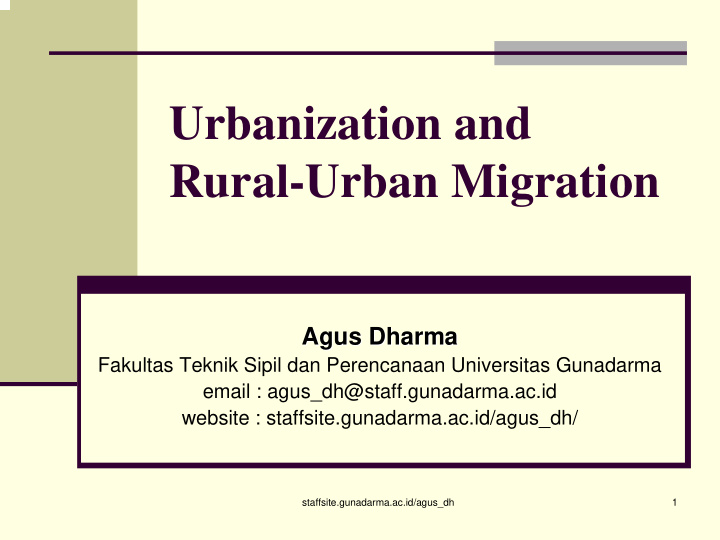



Urbanization and Rural-Urban Migration Agus Dharma Agus Dharma Fakultas Teknik Sipil dan Perencanaan Universitas Gunadarma email : agus_dh@staff.gunadarma.ac.id website : staffsite.gunadarma.ac.id/agus_dh/ staffsite.gunadarma.ac.id/agus_dh 1
Some facts on urbanization � The share of population living in urban areas increases during the development process, i.e. increases with per capita income. � Developing countries are urbanizing at a fasterrate than the countries that are developed today did when they were developing. � In 2001, about 50% of total world population was urban, and 70% of this urban population was located in cities of developing countries. staffsite.gunadarma.ac.id/agus_dh 2
While urban population growth in New York and Tokyo is about 1% per year, it is about 4 to 5% in Asia and Latin America, and over 6% in Africa (Nairobi, Lagos). staffsite.gunadarma.ac.id/agus_dh 3
� Slum settlements represent over 30% of urban population in all developing countries, accounting for up to 60% in many cases (Middle East and Africa). � Bad urban planning and outmoded building codes are partially responsible for these urban shantytowns. staffsite.gunadarma.ac.id/agus_dh 4
5 staffsite.gunadarma.ac.id/agus_dh
Urban Agglomerations Advantages: � cost reductions due to economies of scale and proximity � positive economic externalities: skilled workers, cheap transport � positive social externalities: cultural amenities Disadvantages: � social costs of progressive overloading of housing and social services � increased crime � increased pollution � congestion costs: higher costs of real estate staffsite.gunadarma.ac.id/agus_dh 6
The Role of Cities Cities are formed because they provide cost advantages to producers and consumers (agglomeration economies) 2 Types agglomeration economies: � urbanization economies: the existence of industrial districts or clusters , facilitates technology spillovers � localization economies: refers to reduction in costs due to backward (inputs, skilled workers) and forward (transportation) linkages staffsite.gunadarma.ac.id/agus_dh 7
Urban gigantism problem Problem: in developing countries, capital cities are “urban giants” that suffer from enormous levels of congestion there are not adequate mid-sized cities to provide alternative locations for economic growth Causes : � inheritance of a colonial transportation system designed to extract natural resources � lack of appropriate government intervention to solve the “coordination failure” � “ first city bias ” disproportionate public investment in capital cities staffsite.gunadarma.ac.id/agus_dh 8
Urban informal sector � The informal sector is composed by legal but unregistered, unorganized and unregulated units of production (includes self-employment and smallscale family-owned enterprises). � It reflects the inability of the modern formal sector to absorb the urban labor force. � It represents between 30% and 70% of urban labor force in developing countries, with an average of 50%. � The informal sector plays an important role in developing countries as a major source of employment and income staffsite.gunadarma.ac.id/agus_dh 9
10 staffsite.gunadarma.ac.id/agus_dh
Main Characteristics of the Informal Sector � Free entry, competition, and zero-economic profits � Workers have little formal education and are unskilled � Firms have no access to capital markets � There is no job security, or old-age pensions � Family relatives, specially women and children are involved as workers – labor-intensive sector staffsite.gunadarma.ac.id/agus_dh 11
Recommend
More recommend